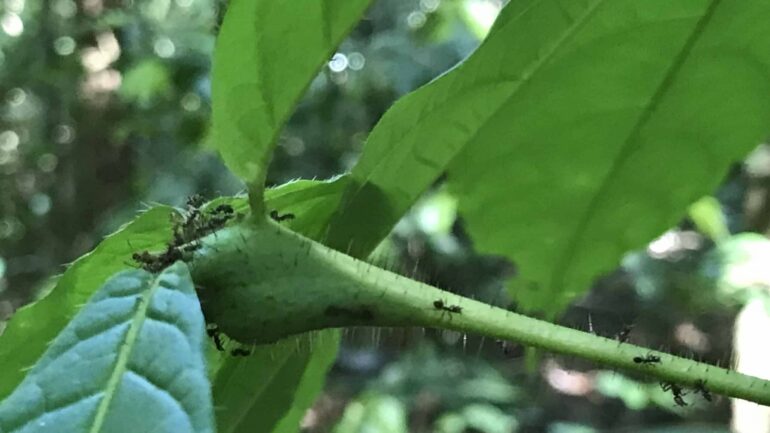A new North Carolina State University study finds that climate change could be destabilizing the mutualistic relationships between insects and plants. The findings, appearing in the journal Ecology, could portend the future fracturing of symbiotic relationships that underpin healthy ecosystems.
In the study conducted in South America, NC State and Peruvian researchers examined the beneficial relationship between certain ant species and tropical shrubs (Cordia nodosa) that house the ants in exchange for defense against plant-eating pests.
The researchers compared the mutualistic relationships between these tropical shrubs and ants in five urban sites and five protected forest sites to understand how they differed. Particular attention was paid to the various species of ant living in hollow portions of the shrubs and how well they tolerated heat—a typical feature of urban environments.
The results showed that urban plants were not defended well by their ant dwellers, which were mostly opportunistic ants not normally associated with C. nodosa plants.
Ants that specialize in this beneficial relationship were still associated with C. nodosa plants in forests, however.
Opportunistic urban ants lived up to their description, generally refusing to come to the plant’s aid when threatened with a finger flick from one of the researchers. The mutualistic ants in forest areas were 13 times more likely to respond to a threat—an expected result.
Unexpectedly, urban plants weren’t decimated without their normal protector ants. Herbivory was relatively low in urban areas.
“I think that probably the herbivores themselves are not doing great in the city, whether it’s because of habitat fragmentation, the temperature or whatever’s keeping those specialist ants out may also be keeping the herbivores out,” said Elsa Youngsteadt, associate professor of applied ecology at NC State and corresponding author of a paper describing the research. “It’s also possible that urban plants have upped their defenses in another way.”
Meanwhile, in forests, plants without their protective ants showed higher rates of herbivory—a more expected result.
Youngsteadt added that the research showed a clear urban heat island effect: the urban areas were about 1.6 degrees Celsius warmer than the forest areas. It also showed that urban ants were, on the whole, more heat-tolerant than forest ants.
“While this study provides a small snapshot of what we may be able to expect in the future with global change, there remain many unanswered questions,” said Sara Prado, co-author of the paper and an adjunct assistant professor of applied ecology at NC State.
“If urban plants do not need ants to protect them, are there any detrimental effects from them being colonized by these opportunistic ants? What is happening with the herbivores? If these changes also play out in forests in the future, we may see more examples of specialized mutualistic interactions changing or disappearing altogether.”
More information:
Elsa Youngsteadt et al, Urbanization drives partner switching and loss of mutualism in an ant–plant symbiosis, Ecology (2024). DOI: 10.1002/ecy.4449
Provided by
North Carolina State University
Citation:
Ant–plant symbiosis study finds climate change may be destabilizing mutualistic relationships (2024, October 14)



